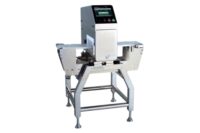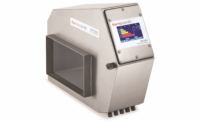By Camilo Sanchez, Product Manager, Metal Detection, METTLER TOLEDO Product Inspection
Metal detectors consist of three coils wound onto a coil former. The center coil–the transmitter–is energized with a high-frequency electric current that generates a magnetic field around the aperture of the metal detector. The two coils on either side of the center coil–the receivers–are identical in size and the same distance from the transmitter, so an identical voltage is induced in each. When the coils are connected in opposition, these voltages cancel out, resulting in “zero output.” When a metal object is present in a product passing through the aperture, it disturbs the magnetic fields due to its ability to conduct electricity and/or because of its magnetic permeability. The disruption in the magnetic field creates a change in the balance of the coils, which indicates metal contamination.
Various factors influence the actual operating sensitivity at which a metal detector is able to perform reliably. The type of metal itself has a large impact. The ease of detection depends on the magnetic properties and electrical conductivity of the metal. Ferrous metals are both magnetic and good electrical conductors, so are easily detected. Non-ferrous metals are non-magnetic, but generally good conductors, so are relatively easy to detect. Stainless steels are usually non-magnetic and poor conductors of electricity, which makes them harder to detect.
What is Product Effect?
Not only metal has the ability to generate magnetic fields and conduct electricity. Food can do this too, although to a lesser extent than metal itself. Salty products, including meats can conduct electricity that will affect the metal detector in the same way as a metal contaminant. “Product effect” is the term used to describe instances where a product's own characteristics affect the metal detector in the same way as a metal contaminant.
Foods with high moisture content–often referred to as “wet products”–are reasonably good conductors and are more likely to produce a signal similar to that of a metal contaminant. This makes distinguishing product from metal contaminants much harder. Moisture and salt content change from pack to pack and from animal to animal. Different cuts of beef, for example, may have different levels of moisture and salt, further complicating matters.
By contrast, “dry” products are less likely to cause substantial change in the magnetic field of the metal detector. An item such as flour, for example, will have no significant impact on the balance state of a metal detector due to its low conductivity and magnetic permeability. Also, some wet products exhibit nearly no product effect when frozen.
What Influences Product Effect?
Because so many factors affect the characteristics of a product, product variations can be difficult to control on a production line. To compensate for these variations, companies seeking to increase productivity will often reduce the sensitivity of online metal detectors to enable the majority of products to pass through the detector without triggering false rejects. However, reducing the sensitivity of the metal detector increases the risk of smaller metal contaminants in products going undetected, and in recent years there have been many product recalls due to this very issue, with companies suffering brand damage and financial losses as a result of having to withdraw products from the supply chain.
In addition to moisture and salt content, a product's temperature also has a major impact on its ability to affect the magnetic field in the metal detector. Changing product temperature alters the product’s conductivity, altering the resulting magnetic field. A frozen product presents like a dry product when frozen, but as it starts to thaw, condensation forms on the outside and changes the product's influence on the magnetic field. Even relatively small temperature changes can affect the signal in a metal detector due to the change in the voltage induced into the receiver coils.
A product's size and shape can also influence its detectable product signal. Packaged products tend to have a uniform shape that produces a consistent product signal, easily interpreted by the detector. Unpackaged products, such as whole chickens, vary significantly in size, shape and weight. In general, a bigger chicken will give a bigger product signal than a smaller chicken.
Even product orientation can impact the product signal. How the product passes through the detector aperture can make it appear smaller in one orientation (sideways) compared to another orientation (lengthwise). Controlling the orientation of a product in production can present a challenge and can dramatically increase variations in the product signal.
The consistency and density of a product can present one of the most challenging Inspections. Consider products such as ready meals. A tray with mashed potatoes, ground meat and gravy, for instance, has a product signal that varies significantly due to variations in both the quantity and ratio of the ingredients.
Packaging materials used in the food industry don't usually impact a metal detector's sensitivity. Metallized film, however, can have an impact, because the relatively high conductivity of the thin layer of aluminum film can generate a large enough magnetic field to be detectable by the metal detector. Traditionally, it was recommended that these products should be inspected before being packaged by the metallized film. However, metal detectors with Multi-Simultaneous Frequency (MSF) technology can now inspect metallized film packaged products and deliver excellent levels of sensitivity.
How to Combat Product Effect without Compromising Sensitivity
Advanced metal detectors, such as Mettler Toledo's Profile Advantage, are specifically designed to dramatically increase detection sensitivity for products that are difficult to inspect. Detectors that incorporate MSF technology use a combination of high and low frequencies, coupled with built-in Product Signal Suppression technology that features two stages of discrimination–frequency and phase. By combining the high and low frequencies, and cancelling the excess signals, the technology removes the product effect signal, allowing much smaller contaminants to be detected.
MSF is also able to deal with product variations in a very effective manner. The Profile Advantage software algorithms, for example, deal with variations in product effect for each product inspected. The result is up to a fifty per cent improvement in metal detection spherical sensitivity levels compared to conventional metal detectors, making it possible to detect significantly smaller and irregularly shaped metal contaminants.
Maximizing Uptime and Productivity
As well as increasing contaminant detection, it's important to consider a metal detector's efficiency and productivity. The Profile Advantage, for example, features an on-board condition monitoring system developed to support preventive maintenance. The Profile Advantage monitors its own performance and functionality and, when a change is detected, triggers an alarm to alert the operator. By alerting in advance of a potential failure developing within the system, the alarm enables maintenance engineers to rectify the problem quickly, avoiding costly and unnecessary downtime.
Many advanced metal detectors also conduct on-board overall equipment effectiveness (OEE) reporting on availability, reliability and quality easy, allowing the system to be scrutinized remotely as data is reviewed as part of overall production line performance. Such detectors can be supplied with a Fieldbus Integration Module (FIM) to allow connection to a range of industry standard protocols (Ethernet/IP, Profinet IO or Modbus TCP), enabled devices such as PLCs and Manufacturing Execution Systems (MES).
To aid Hazard Analysis and Critical Control Points (HACCP) compliance, the Profile Advantage is equipped with on-screen HACCP reporting. Login processes can be monitored through a Metal Detector Access Log that records details of all logins to the controls of the metal detector, the name of the operator and the time and date of all change occurrences.
For increased access security, a high level access software routine is also provided which complies with FDA 21 CFR Part 11. Access to the metal detector's controls is protected by a dual level username and password login.
By conquering the product effect phenomenon, these advanced metal detectors provide greater confidence that all products manufacturers send into the retail supply chain are free from even the smallest metal contaminants, increasing brand protection while simultaneously reducing costs and improving productivity.
For more information visit www.mt.com/pi.




Report Abusive Comment